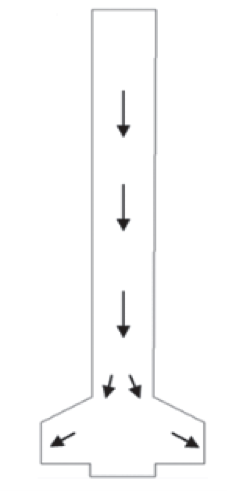Apart from rendering primary functions like containment of steel and preventing reoxidation, recent developments in ladle shroud technology have shown promises for fluid flow control and acting as slag carry-over detection device. The potentials of metal heating and additive feeding are some of the future scopes for developments which is still under exploration.
The initial ladle shroud made of silica had a relatively short service life. It was replaced by alumina graphite refractories. Zirconia was added around the slag line which reacts with tundish slag and forms a layer that prevents the penetration of slag and thereby improves the corrosion resistance. The inner wall is made devoid of carbon (peroxidized to remove carbon) which acts as a heat insulator reducing thermal shock and also reduces thermal stress at the point of contact.
Coating at the outer surface with materials (glazing) provides better splash resistance, heat insulation and prevent air infiltration. Antioxidants addition (metallic additions like Al, Si) facilitates the reduction of CO to C and also prevents oxidation loss of carbon. Development in outer coating technology and the inner pre-oxidized layer has further helped to achieve higher life.
Ladle shroud with high tension and toughness properties can be developed. The high tensile strength can be achieved by reinforcing carbon bonding, whereas uniform strength can be achieved by distributing grains and binders evenly whereas low elasticity can be obtained by optimizing grain size and their distribution.
Nano additives (carbon nanotube, MgAl2O4, Al2O3) have been found very effective in improving strength and thermal shock performance of the shroud by reinforcing the binder matrix with the homogeneous distribution of the nanoscaled spinel additives.
Optimizing flow pattern
The flow pattern inside the tundish is mostly determined by the design of the shroud as well as by the tundish operations like submergence depth.
Trumpet-shaped ladle shroud (TLS or bell-shaped ladle shroud), has a trumpet outlet with an enlarged bore. TLS can be classified into two types, one with a gradually enlarged trumpet and the other with divergent chamber and a straight end. The increase in outlet diameter of the ladle shroud decreases the jet velocity, which reduces the turbulence both in the ladle shroud and the pouring zone of a tundish.
The main feature of TLS is its capability to eliminate blowbacks during a ladle change.TLS has the ability to minimize turbulence in the pouring area (facilitating calm tundish bath level), prevent nozzle chocking, eliminate slag entrapment, maintain minimal turbulence during tundish filling , reduce impact and steel splashing during ladle opening, reduce lining erosion and air pickup. Thus TLS has the potential to improve steel cleanliness and flow characteristics within a tundish.
A steady tundish surface level was achieved by using the TLS, as compared to a conventional ladle shroud (CLS). An eccentric tundish open eye formation along with waving flux with flames was some of the characteristic observation during steady-state casting when CLS is used.
A newly-developed ladle shroud called dissipative ladle shroud (DLS) has three diamond-shaped chambers and a bell outlet.



